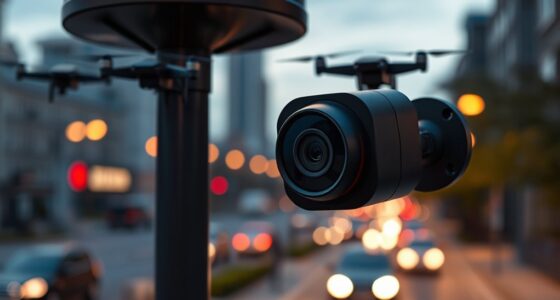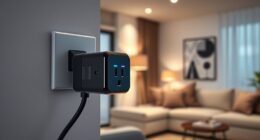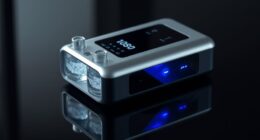If you’re searching for the best portable 3D scanners of 2025, I can help. I focus on models that are compact, highly accurate, and easy to operate—perfect for fieldwork, creative projects, or quick scans. From lightweight handheld devices like Revopoint MetroX and Creality CR-Ferret SE to advanced all-in-one options like EINSTAR Vega, there’s a solution for every need. Keep exploring to discover more about these top choices and their features.
Key Takeaways
- The latest models offer high precision, with accuracies down to 0.02mm, suitable for detailed professional applications.
- Compact and lightweight designs ensure easy portability for outdoor, field, and on-the-go scanning tasks.
- Support multiple scanning modes and high-quality color capture for versatile, realistic 3D model creation.
- Seamless multi-platform connectivity via Wi-Fi 6 and USB-C simplifies setup and data transfer.
- User-friendly interfaces and quick setup make these scanners accessible for both beginners and experts.
EINSTAR Vega 3D Scanner with Tripod
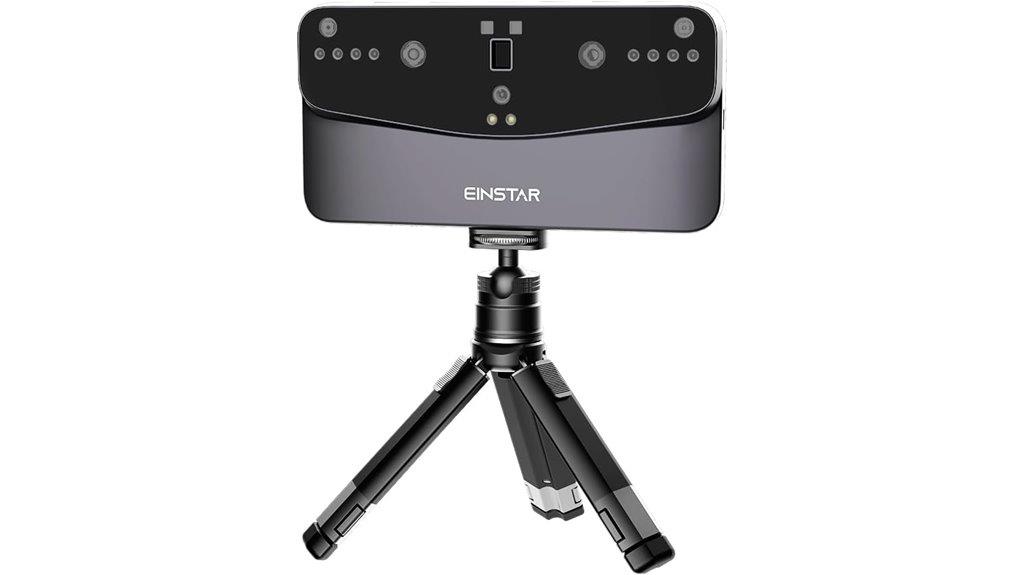
Looking for a versatile portable 3D scanner that adapts to different project needs? The EINSTAR Vega 3D Scanner with Tripod fits the bill perfectly. It offers two modes: Fast Mode for larger objects up to 1500mm and HD Mode for detailed small to medium items. Its outdoor scanning capability uses infrared light, so sunlight or dark surfaces aren’t a problem. Compact and all-in-one, it includes dual projectors, internal storage, and a bright touch screen. Plus, wireless connectivity and cloud sharing make it easy to scan, save, and share data anywhere. It’s designed for users of all levels, simplifying complex tasks with smart features and high-quality results.
Best For: users seeking a versatile, portable 3D scanning solution suitable for both large and detailed small to medium objects, indoors and outdoors.
Pros:
- Offers dual scanning modes (Fast and HD) for a wide range of object sizes and detail levels.
- Supports outdoor scanning with infrared light, unaffected by sunlight or dark surfaces.
- Compact all-in-one design with built-in storage, high-resolution display, and wireless connectivity for easy, on-the-go use.
Cons:
- May require some familiarity with scanning software despite user-friendly features.
- Limited to 15-20 FPS, which might be slower for high-speed batch scanning.
- The device’s high-end hardware and features could be costly compared to basic scanners.
Creality 3D Scanner CR-Scan Ferret Pro for 3D Printing
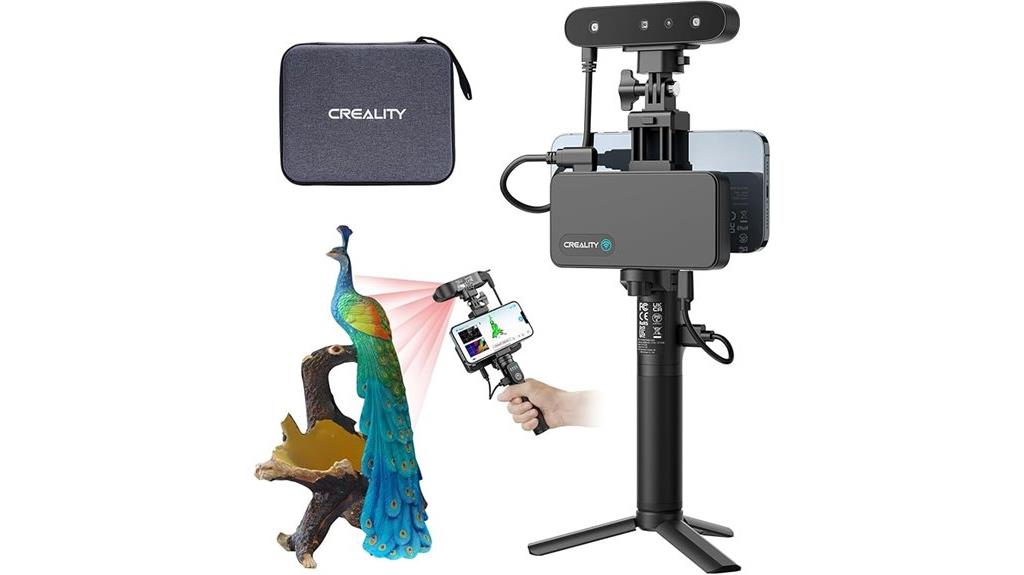
The Creality CR-Scan Ferret Pro stands out as an excellent choice for hobbyists, educators, and small-scale professionals who need a portable, high-precision 3D scanner. Weighing just 105 grams, it’s designed for on-the-go scanning, supporting full-color, 0.1mm accuracy outputs in OBJ, STL, and PLY formats. Its advanced optics and intelligent algorithms perform well in various lighting conditions, including sunlight. With WiFi6 connectivity, anti-shake tracking, and compatibility across multiple platforms, it’s easy to use—though it requires some practice to perfect results. Overall, it’s a versatile tool for creating detailed models, especially when paired with accessories like a turntable and markers.
Best For: hobbyists, educators, and small-scale professionals seeking a portable, high-precision 3D scanner for detailed color models and versatile applications.
Pros:
- Lightweight and portable at only 105 grams, ideal for on-the-go scanning.
- Supports full-color, high-accuracy scans with multiple output formats (OBJ/STL/PLY).
- Compatible with various platforms and includes features like WiFi6 and anti-shake tracking for ease of use.
Cons:
- May require a learning curve and practice to achieve optimal results.
- Occasional tracking loss and inconsistent scans with complex or poorly textured objects.
- Software limitations may necessitate post-processing and mesh repair for perfect models.
Revopoint MetroX 3D Scanner for 3D Printing
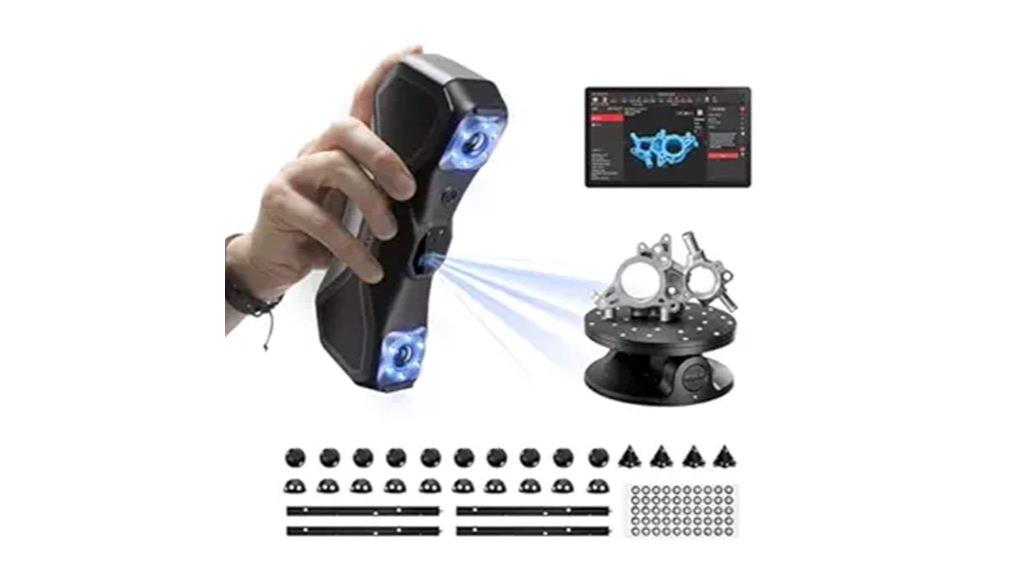
If you need a portable 3D scanner that delivers industrial-grade precision, the Revopoint MetroX is an excellent choice for 3D printing professionals and enthusiasts alike. It features blue laser scanning with up to 0.02 mm accuracy and a precision of 0.01 mm, capturing detailed point clouds at 60 fps. Its dual structured light with 14 crossed laser lines handles dark or shiny surfaces without spray in many cases. Compatible with Windows and macOS, it supports multiple modes—handheld, fixed, turntable—and offers automated scans via Auto Turntable. With user-friendly software and high-quality data capture, the MetroX simplifies complex scans for precise, ready-to-print 3D models.
Best For: 3D printing professionals and enthusiasts seeking industrial-grade precision and versatile scanning options for complex or reflective objects.
Pros:
- High accuracy of up to 0.02 mm and precision of 0.01 mm for detailed 3D models
- Supports multiple scanning modes including handheld, fixed, and automated turntable for flexibility
- Capable of capturing vibrant color data and handling dark or shiny surfaces with dual structured light technology
Cons:
- Requires surface preparation (e.g., spray) for shiny or reflective objects to achieve optimal results
- Slightly higher cost compared to entry-level 3D scanners suitable for hobbyists
- May have a learning curve for new users unfamiliar with 3D scanning workflows
Creality CR-Ferret SE 3D Scanner for 3D Printing

For professionals seeking precise and reliable 3D scanning, the Creality CR-Ferret SE stands out with its high accuracy of up to 0.1mm and fast 30FPS capture speed. It captures detailed and extensive data quickly, making it ideal for creating realistic models. Its advanced one-shot imaging technology provides stable scans even with shaky hands or rapid movement, simplifying the process for beginners. The built-in 2MP color camera records vivid textures and colors, bringing models to life. With a flexible range from 150mm to 2000mm and compatibility with black or metallic surfaces, it’s versatile, easy to use, and perfect for diverse 3D printing projects.
Best For: professionals and enthusiasts seeking high-precision, fast, and versatile 3D scanning for detailed, large, or reflective objects.
Pros:
- High accuracy up to 0.1mm ensures precise and reliable scans.
- Fast capture speed of 30FPS allows quick data collection for efficient workflows.
- Advanced one-shot imaging technology provides stable scans even with shaky hands or movement.
Cons:
- May be more expensive compared to entry-level scanners.
- Large scanning range might be unnecessary for small object projects.
- Performance on highly reflective or extremely dark surfaces, despite optimization, may still pose challenges in some cases.
Creality 3D Scanner CR-Scan Ferret Pro for 3D Printing

Designed for users who need high-precision, full-color 3D scans on the go, the Creality CR-Scan Ferret Pro stands out as an ideal choice for hobbyists, educators, and professionals working in field environments. Weighing just 105 grams, it’s highly portable and supports multiple formats like OBJ, STL, and PLY. Its advanced optics and intelligent algorithms ensure accurate results in various lighting conditions, including sunlight. With WiFi6 connectivity, anti-shake tracking, and 24-bit color scans at 0.1mm accuracy, it’s versatile yet requires patience and practice. Perfect for small to medium objects, it’s best used with accessories like turntables and markers for maximum results.
Best For: hobbyists, educators, and professionals who need portable, high-precision full-color 3D scans for small to medium objects in field or on-the-go environments.
Pros:
- Lightweight and highly portable at only 105 grams, ideal for fieldwork and mobile use
- Supports multiple output formats (OBJ, STL, PLY) for versatile applications
- Performs well in various lighting conditions, including sunlight, thanks to advanced optics and algorithms
Cons:
- Steep learning curve with some users experiencing frequent tracking loss and inconsistent results
- Requires patience, practice, and proper techniques like markers or turntables for optimal scans
- Software may lack advanced features, necessitating additional post-processing and mesh repair
Revopoint POP3 Plus 3D Scanner for 3D Printing
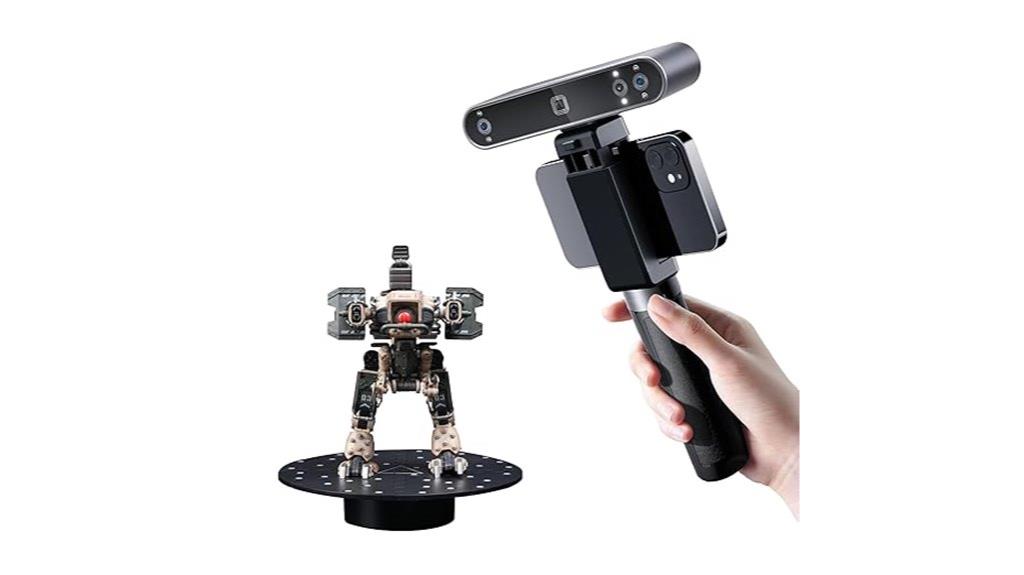
The Revopoint POP3 Plus 3D Scanner stands out as an ideal choice for professionals and hobbyists seeking high-precision, portable 3D scanning on the go. Weighing just 190 grams, it’s easy to handle and supports Android, iOS, Windows, and macOS via Wi-Fi 6 or USB Type-C, ensuring seamless connectivity. With 20% improved accuracy within 20 microns and a new optical zoom, it captures detailed, color-rich models quickly—up to 18 fps. Its full-color scans, stability features, and user-friendly software make it perfect for 3D printing, modeling, or preservation projects. Whether you’re in the studio or in the field, POP3 Plus delivers professional results effortlessly.
Best For: professionals and hobbyists seeking portable, high-precision 3D scanning for printing, modeling, and preservation projects across various devices.
Pros:
- Supports multiple device platforms including Android, iOS, Windows, and macOS via Wi-Fi 6 or USB Type-C
- Achieves 20% improved accuracy within 20 microns with enhanced detail capture
- Lightweight and portable at only 190 grams, suitable for on-the-go use
Cons:
- Software compatibility limited to x86_64 architecture, potentially restricting some users
- May require a learning curve for new users to fully utilize advanced features
- Limited to medium-sized objects (20mm to 2m), not ideal for very small or very large objects
Creality Otter Lite 3D Scanner, Wireless 3D Scanner for 3D Printing
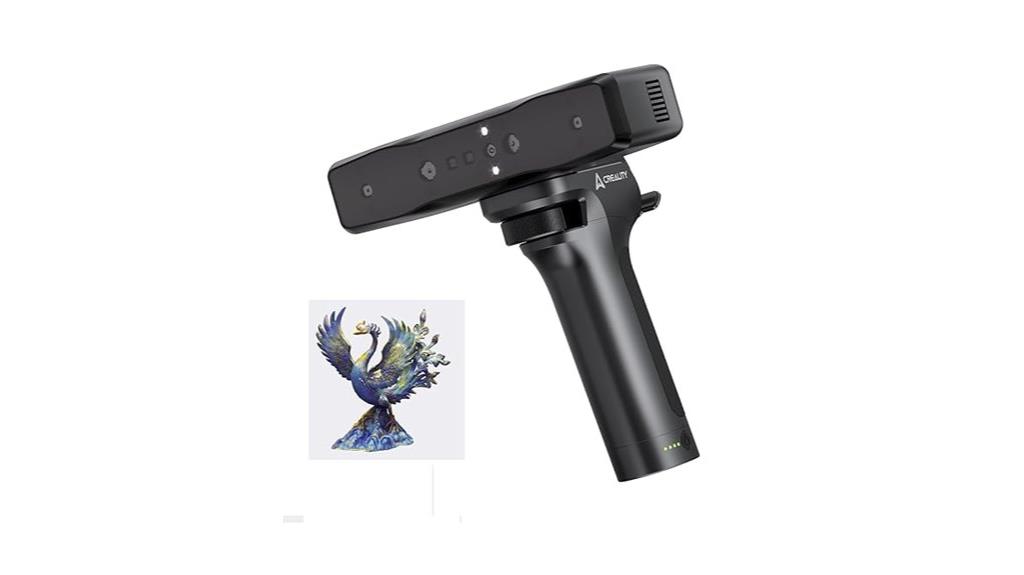
If you need a portable 3D scanner that combines high precision with wireless convenience, the Creality Otter Lite stands out as an ideal choice. Its compact design makes it perfect for various environments, from industrial to automotive settings. With WiFi 6 connectivity, it seamlessly connects to Windows, macOS, Android, and iOS devices via the Lite Bridge battery handle. The advanced structured-light stereo vision captures details as small as 20mm and objects up to 2000mm, even on black or metal surfaces without surface spraying. Its full-color camera provides realistic textures, and with fast, smooth scanning at 30 FPS, it’s both efficient and user-friendly.
Best For: professionals and hobbyists seeking portable, high-precision 3D scanning and printing solutions across industrial, automotive, and creative environments.
Pros:
- Wireless connectivity with WiFi 6 for seamless multi-platform use
- High-precision scanning of small details (20mm) and large objects (2000mm) without surface spraying
- Full-color imaging with realistic textures suitable for detailed rendering
Cons:
- May require compatible devices and setup for optimal performance
- Limited to objects within the specified size range; not suitable for very large or very tiny items
- Battery life and connectivity stability could vary based on environment and usage conditions
Revopoint MIRACO Plus 3D Scanner for 3D Printing

For professionals and enthusiasts seeking high-precision 3D scanning on the go, the Revopoint MIRACO Plus stands out as an ideal choice. It combines advanced photogrammetric metrology with enhanced optics, including infrared zoom and a 48MP RGB camera, delivering 0.02 mm accuracy. Its dual scanning modes—single-shot and continuous—offer flexibility for small details or large surfaces. Lightweight at 750g, it’s highly portable, with a sturdy case and a 2-hour battery life. Powered by fast processing and supporting multiple export formats, the MIRACO Plus is perfect for detailed 3D printing, reverse engineering, and fieldwork, making high-quality scans accessible anywhere.
Best For: professionals and enthusiasts who need high-precision, portable 3D scanning for detailed models, reverse engineering, or fieldwork.
Pros:
- High accuracy of 0.02 mm with advanced photogrammetric metrology and enhanced optics.
- Lightweight and portable design weighing only 750g, ideal for on-the-go use.
- Supports multiple export formats and features quick processing with a user-friendly workflow.
Cons:
- Struggles with very small, dark, or shiny objects, requiring sprays or additional preparation.
- Native alignment tools can sometimes misalign scans, affecting final model quality.
- Battery life may be limited when using onboard lights, reducing continuous scanning time.
Shining 3D Einstar Handheld 3D Scanner
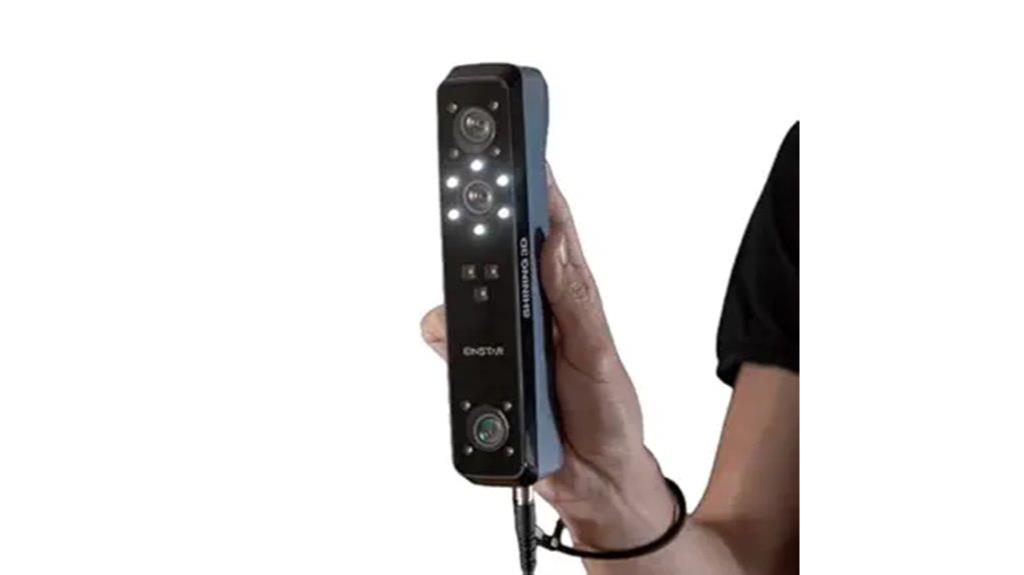
Anyone seeking a handheld 3D scanner that combines high accuracy with ease of use will find the Shining 3D Einstar ideal, thanks to its ability to capture high-density point clouds with a remarkable 0.1mm point distance. It features a built-in RGB camera for vibrant color capture and supports detailed scans of hair and human bodies, making it versatile for various applications. Its intelligent software enhances data quality through automatic alignment and detail optimization, while the fast scanning speed of up to 14 FPS ensures efficiency. Designed for outdoor stability and user comfort, Einstar supports multiple data formats, simplifying integration into workflows for 3D printing, design, and preservation.
Best For: professionals and hobbyists seeking high-accuracy, portable 3D scanning for applications in design, digital archiving, cultural preservation, and education.
Pros:
- Captures high-density point clouds with up to 0.1mm point distance for precise detail.
- Supports vibrant color data collection with a built-in RGB camera, enhancing realism.
- Fast scanning speeds of up to 14 FPS and stable outdoor performance for versatile use.
Cons:
- May require compatible software and post-processing skills for optimal results.
- Limited to USB connectivity, which could restrict mobility in certain environments.
- The cost may be high for casual users or small-scale projects.
Creality CR-Scan Ferret Pro 3D Scanner
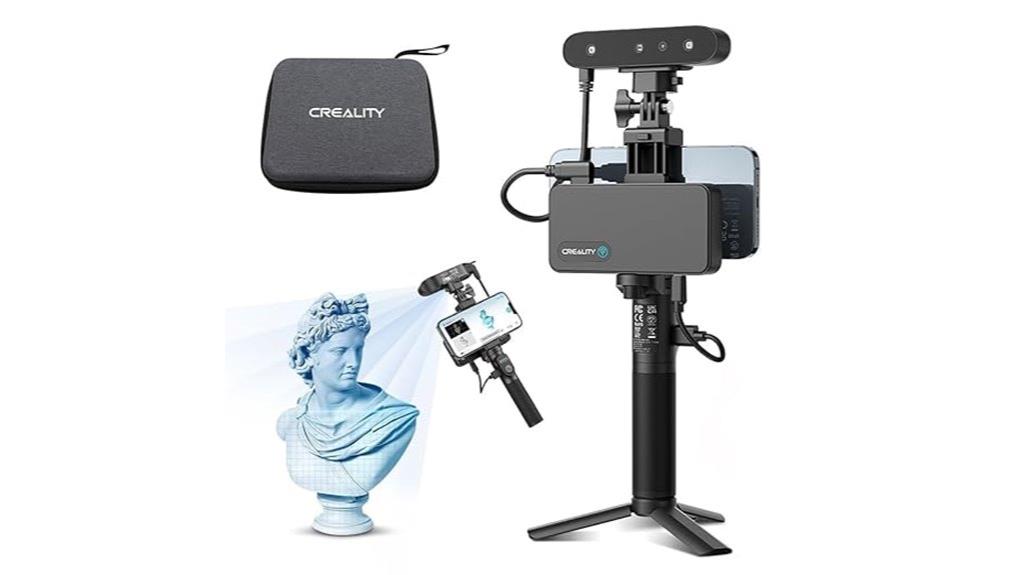
The Creality CR-Scan Ferret Pro 3D Scanner stands out for its lightning-fast wireless connectivity powered by WiFi 6, making it ideal for professionals and creators who need high-precision scans on the go. It supports wireless connections via WiFi and USB, compatible with Windows, Mac, iOS, and Android devices, and pairs easily thanks to quick setup guides and tutorials. It delivers vivid 24-bit full-color scans with 0.1mm accuracy and 0.16mm resolution, capturing fine details on challenging surfaces like black or metallic objects. With anti-shake tracking and a portable design, it’s perfect for diverse environments and high-quality, reliable results.
Best For: professionals and creators who require high-precision, portable 3D scanning with fast wireless connectivity for diverse environments.
Pros:
- Supports lightning-fast WiFi 6 for seamless wireless data transfer
- Delivers vivid 24-bit full-color scans with high accuracy (0.1mm) and resolution (0.16mm)
- Portable design with comprehensive accessories for easy setup and versatile use
Cons:
- May be more expensive compared to basic 3D scanners
- Requires compatible devices and operating systems for optimal performance
- Limited to wireless and USB connections, which might not suit all workflows
3D Scanner for 3D Printing, Handheld 0.05mm Precision
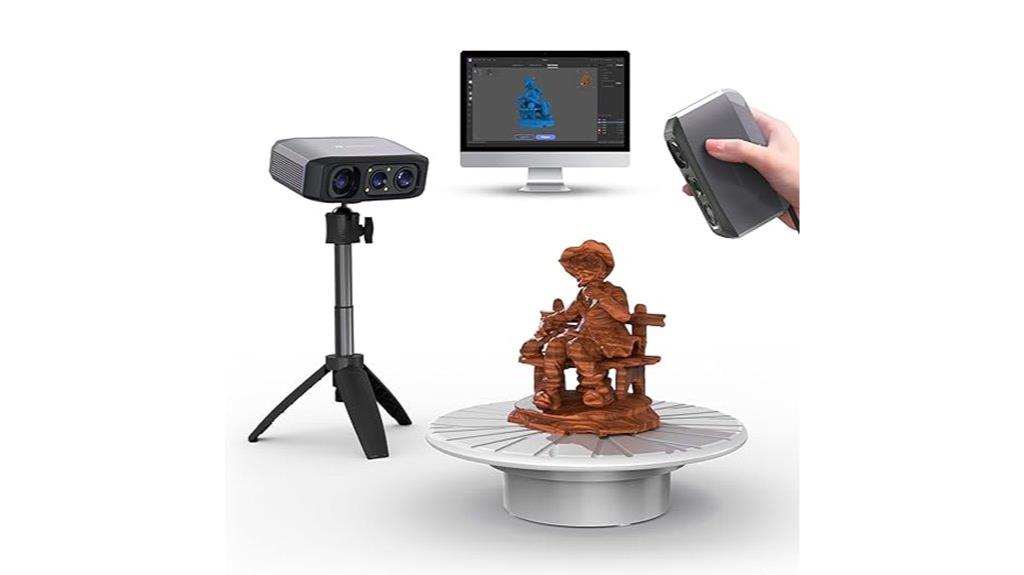
With its remarkable 0.05mm precision and advanced blue light technology, the Moose Lite handheld scanner is ideal for hobbyists and professionals seeking highly detailed 3D models for printing. It captures accurate point clouds that preserve fine features, supporting complex and intricate objects. The scanner’s enhanced depth exploration of up to 100mm makes it versatile for small-scale models. Its AI tracking and smart algorithms simplify data processing, while JMStudio software streamlines editing and exporting in multiple formats. Compact and lightweight at just 250g, Moose Lite is portable and suitable for on-the-go scanning. Though it requires practice, it delivers impressive detail and versatility for 3D printing projects.
Best For: hobbyists and professionals who require highly detailed 3D scans for printing, especially on intricate or small-scale objects.
Pros:
- Achieves exceptional 0.05mm precision with detailed point cloud capture.
- Supports comprehensive scanning with up to 100mm depth and works well in various lighting conditions.
- Seamless workflow with JMStudio software for editing, exporting, and optimizing models.
Cons:
- Steep learning curve requiring time and patience to master.
- Software can be confusing, with a limited interface and slow processing times on high-end PCs.
- Reliance on multiple cables and no dedicated power switch, which may affect portability and convenience.
Creality Ferret Pro 3D Scanner for 3D Printing
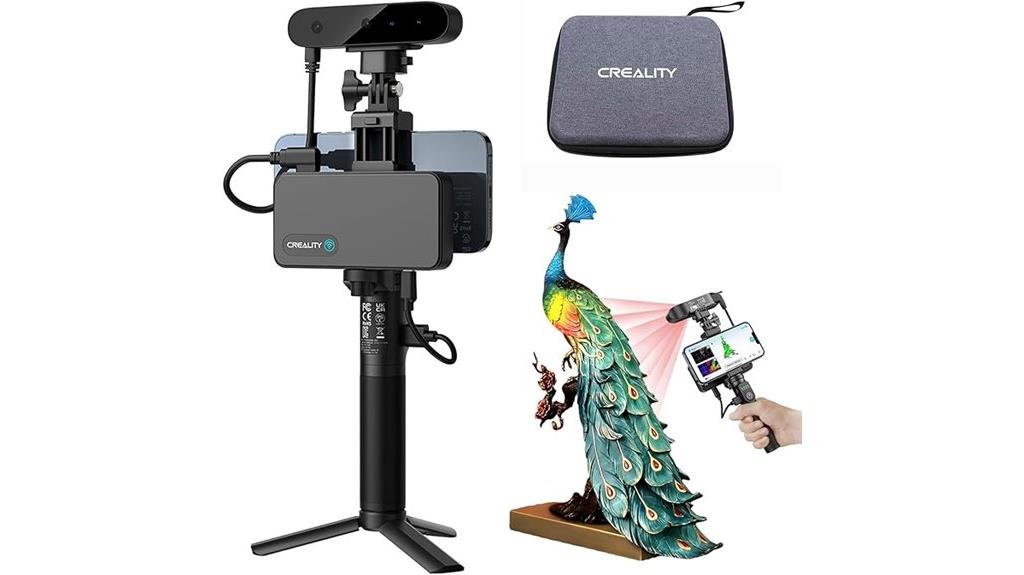
If you’re looking for a portable 3D scanner that combines speed, precision, and ease of use, the Creality Ferret Pro stands out as an ideal choice for 3D printing enthusiasts and professionals alike. It uses innovative one-shot 3D imaging technology, enabling smooth scans even with shaky hands and capturing high-density point clouds with up to 0.1mm accuracy. With a large working distance of 150-700mm and support for outdoor scanning under bright sunlight, it’s versatile. Plus, the built-in color camera preserves fine details and colors, while WiFi 6 connectivity makes mobile scanning quick and effortless. This scanner truly balances performance and convenience for medium-sized object scanning.
Best For: 3D printing enthusiasts and professionals seeking a portable, high-precision scanner with fast, color-rich scans for medium-sized objects and outdoor use.
Pros:
- Utilizes innovative one-shot 3D imaging technology for smooth, shake-tolerant scans.
- Captures high-density point clouds with up to 0.1mm accuracy and full-color details.
- Supports outdoor scanning in bright sunlight and connects seamlessly via WiFi 6 for mobile convenience.
Cons:
- Speed depends on computer performance, which may affect workflow efficiency.
- Optimal for medium-sized objects; may be less suitable for very small or very large items.
- Requires compatible software for processing and may have a learning curve for new users.
Einstar Handheld 3D Scanner Pro
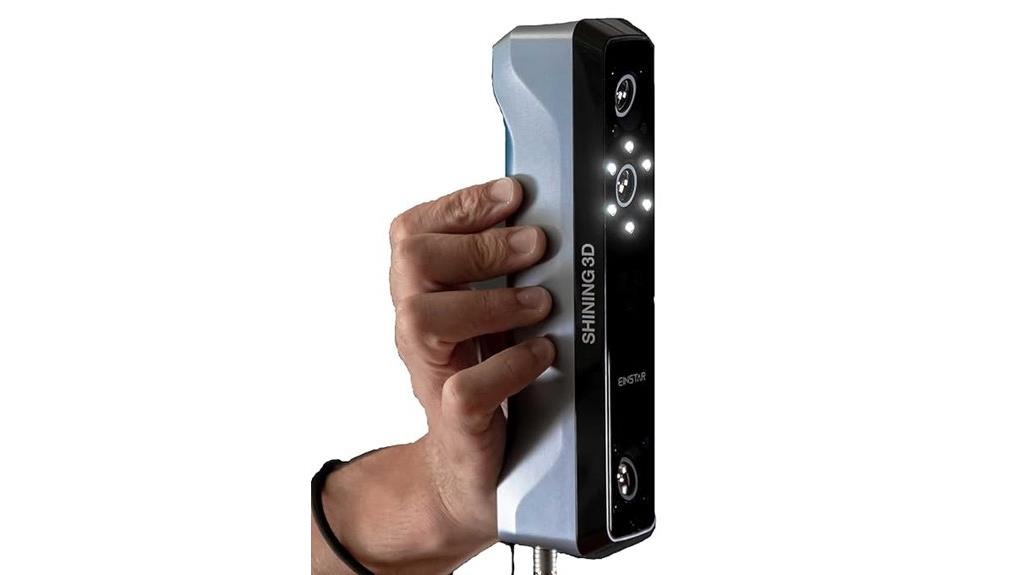
Designed for professionals and hobbyists alike, the Einstar Handheld 3D Scanner Pro stands out through its lightweight, ergonomic build that weighs under 1kg, making it easy to carry and use anywhere. Its user-friendly design allows for seamless data capture in various environments without needing external markers or complex setups. Compatible with Windows 10 and macOS Ventura, it supports major file formats like OBJ, STL, and PLY, ensuring smooth integration into diverse workflows. Equipped with infrared VCSEL structured light technology, it scans complex surfaces accurately while minimizing damage risks. Its high-resolution RGB camera captures vivid, realistic colors with up to 0.1mm precision, making it ideal for detailed, professional-quality 3D modeling.
Best For: professionals and hobbyists seeking portable, high-precision 3D scanning with vibrant color capture and easy workflow integration.
Pros:
- Lightweight, ergonomic design under 1kg for effortless portability and use in diverse environments
- Advanced infrared VCSEL structured light technology ensures accurate scans on complex, shiny, or dark surfaces
- High-resolution RGB camera captures vivid, photorealistic colors with up to 0.1mm precision
Cons:
- May require a compatible high-performance computer for optimal operation, especially on macOS
- Limited to specific file formats which might necessitate additional conversions for some workflows
- As a handheld device, it may require steady handling to achieve the highest accuracy in detailed scans
Creality CR Scan Ferret Pro 3D Scanner
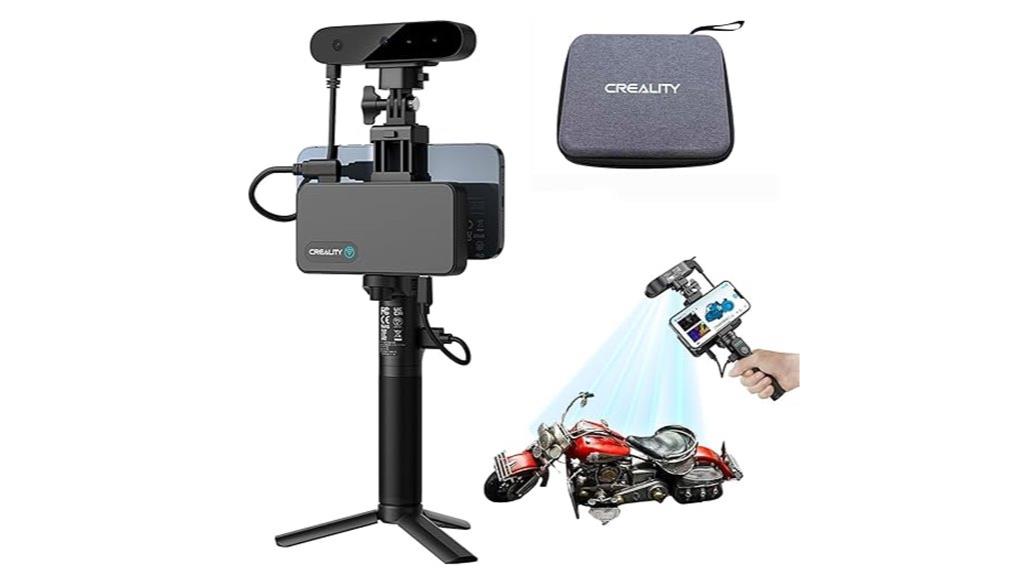
The Creality CR Scan Ferret Pro stands out as the perfect choice for beginners and professionals alike who need a portable, high-precision 3D scanner. It offers professional-grade 0.1mm accuracy with easy operation, making it simple to turn real objects into detailed models. Compatibility across Mac, Windows, Android, and iOS, along with wireless connectivity via WiFi 6 or USB, ensures flexible workflows. Weighing only 105 grams, it’s lightweight and perfect for outdoor or on-the-go use. Its advanced features include real-time anti-shake stabilization and full-color texture capture, making it ideal for capturing complex surfaces without extra prep.
Best For: beginners and professionals seeking a portable, high-precision 3D scanner for detailed object capture in various environments and on multiple operating systems.
Pros:
- Professional-grade 0.1mm accuracy with easy, user-friendly operation
- Supports seamless connectivity across Mac, Windows, Android, and iOS devices with wireless options
- Lightweight (105 grams) and portable, suitable for outdoor, on-the-go, and diverse project settings
Cons:
- May require initial setup and tutorials for complete beginners
- Limited to specific advanced features, which might not suit very high-end industrial scanning needs
- Performance could be affected in extremely bright sunlight or highly reflective metallic surfaces without specialized modes
Seal Lite Handheld 3D Scanner for 3D Printer
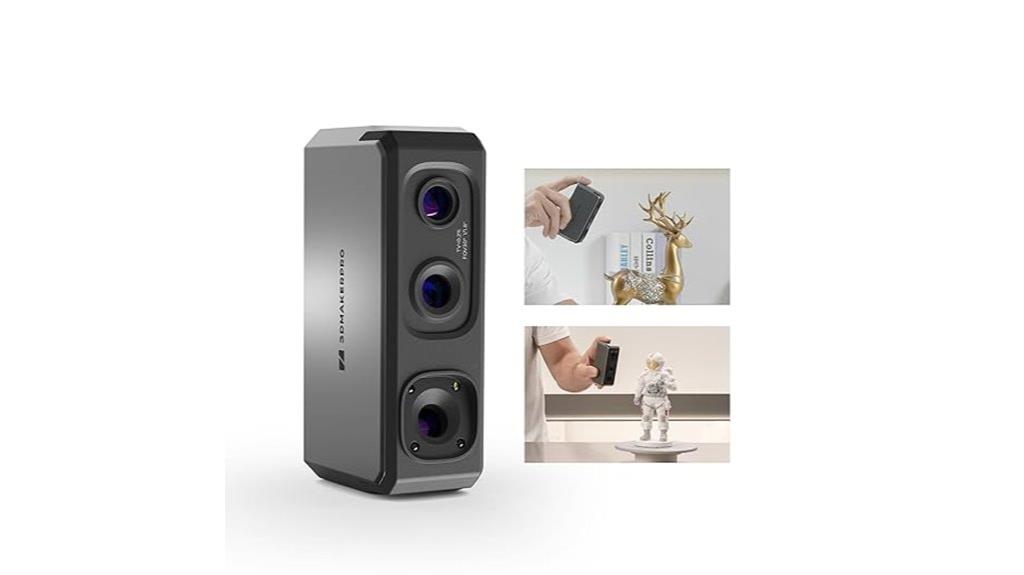
The Seal Lite Handheld 3D Scanner stands out as an ideal choice for hobbyists, students, and small-scale manufacturers seeking accurate, portable scanning without breaking the bank. It uses refined structured light with a blue imaging system, achieving 0.02mm accuracy and capturing detailed models at 100,000 points per second. Weighing just 225g, its lightweight design includes anti-shake lenses and adjustable lighting for versatile use in various environments. While it performs well on small objects and simple shapes, it struggles with dark or shiny surfaces and has limited software features. Overall, it offers good value for small projects, especially for beginners and those on a budget.
Best For: hobbyists, students, and small-scale manufacturers seeking affordable, portable, and detailed 3D scanning for small objects and simple shapes.
Pros:
- High accuracy of 0.02mm and fast scanning rate of 100,000 points per second for detailed models.
- Lightweight and portable at only 225g, with anti-shake lenses and adjustable lighting for versatile use.
- Compatible with Windows and MacOS, supporting multiple file formats and easy beginner-friendly software.
Cons:
- Struggles with dark, shiny, or black surfaces, limiting usability on certain objects.
- Limited software features, especially in auto-alignment and detailed scanning of larger or complex items.
- Requires an external power supply and has a narrow field of view, restricting larger or more intricate scans.
Factors to Consider When Choosing Portable 3D Scanners
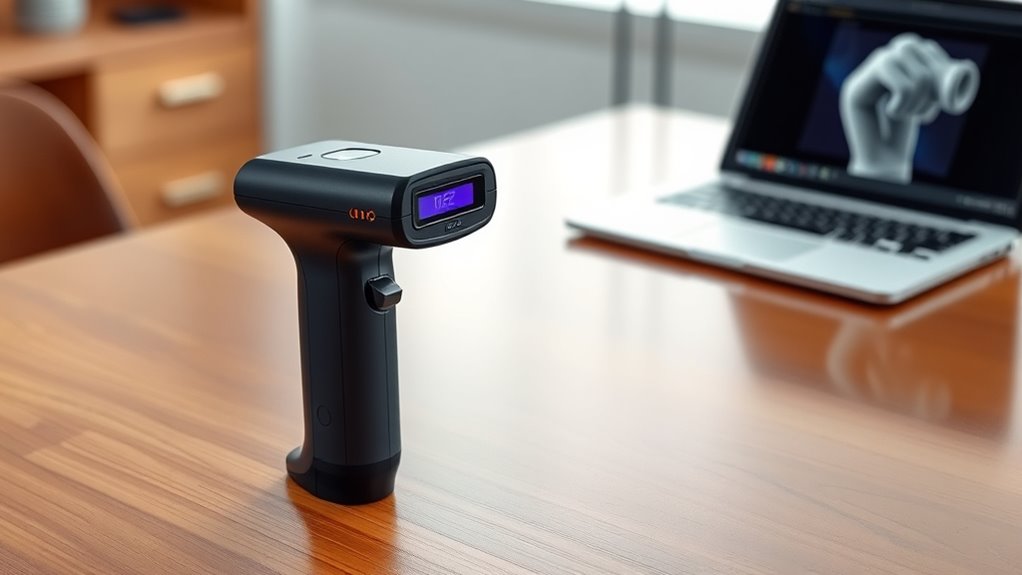
When selecting a portable 3D scanner, I always consider key factors like accuracy and resolution to guarantee precise results. I also look at portability, surface compatibility, and scanning speed to fit my workflow needs. Plus, software integration plays a big role in making the scanning process smooth and efficient.
Accuracy and Resolution
Choosing the right portable 3D scanner hinges on understanding its accuracy and resolution, as these factors directly impact the level of detail you can capture. Accuracy typically ranges from 0.02mm to 0.1mm, affecting how precisely the scanner records measurements. Higher accuracy means better detail, especially for small or intricate objects. Resolution, measured through point spacing or mesh detail, determines how finely surface features are represented. For applications like jewelry or micro-precision parts, a high resolution is essential. Keep in mind that environmental factors such as lighting, surface reflectivity, and movement can influence both accuracy and resolution. Ultimately, selecting a scanner with the appropriate specs depends on your specific needs—whether quick prototyping or detailed inspections.
Portability and Size
Selecting a portable 3D scanner requires careful consideration of its size and weight to guarantee it fits your workflow. Ideally, it should be under 1 kg for easy handling during long sessions. Compact dimensions, similar to a small tablet or handheld device, boost maneuverability in tight or complex spaces. Foldable or foldable-like designs can enhance transport and storage without sacrificing performance. Protective covers or integrated cases help safeguard the device during travel, preserving durability and accuracy. A smaller form factor allows for quick setup and efficient scanning across various locations, making it perfect for fieldwork, on-site inspections, or mobile workflows. Prioritizing portability ensures you can seamlessly integrate the scanner into your environment without compromising ease of use or reliability.
Surface Compatibility
Surface compatibility plays a crucial role in guaranteeing your portable 3D scanner delivers accurate and complete results across different materials. Some surfaces, like shiny or dark objects, can challenge scanners, especially those using visible light. Infrared laser and structured light technologies are often better suited for these problematic surfaces because they’re less affected by reflectivity. Certain scanners even recommend surface treatments, such as sprays or powders, to improve data capture on metallic or black items. The scanner’s ability to handle various colors and textures directly impacts the quality of your 3D models. While advanced models support a wide range of materials right out of the box, entry-level options might require some surface prep for ideal results. Choosing a scanner with good surface compatibility ensures reliable, high-quality scans across different materials.
Scanning Speed
Ever wondered how scanning speed affects your 3D capture process? It’s a vital factor that determines how efficiently you can scan objects. Higher FPS, like 20-60, allows for quick data collection, ideal for real-time applications and large or moving objects. However, this speed often comes with a trade-off—some loss in detail or accuracy. On the other hand, lower FPS, around 10-15, offers higher resolution and finer detail but takes longer to complete scans. The ideal balance depends on your scanner’s hardware, such as processing power and sensor technology. Rapid scanning reduces operator fatigue and boosts productivity, especially when dealing with multiple objects or large projects. Choosing the right speed means balancing your need for detail against your project’s time constraints.
Software Integration
Choosing the right portable 3D scanner hinges heavily on its software integration capabilities, as seamless data transfer and compatibility can substantially streamline your workflow. I look for scanners that easily export files in common formats like OBJ, STL, PLY, or ASC, ensuring flexibility across different platforms. Real-time data processing and automatic alignment features boost accuracy and reduce manual corrections, saving time. A user-friendly interface with tutorials helps me operate the scanner efficiently, even if I’m new to 3D scanning. Cloud connectivity is also a big plus, allowing me to share models easily and back up data remotely. Good software integration means less hassle and more focus on the creative or manufacturing process, making it a critical factor in my decision.
Power and Battery Life
When evaluating portable 3D scanners, power and battery life become key considerations, especially if I plan to use the device outdoors or in the field. A longer battery life means I can scan continuously without constantly looking for power sources. Devices with at least 2000mAh batteries typically last between 1.5 to 3 hours, depending on usage. Fast-charging capabilities are also essential, as they reduce downtime between sessions, which is critical during extended projects. For wireless models, battery management is especially important to prevent unexpected shutdowns. Some high-end scanners come with external power banks, allowing me to extend operation without recharging. Ultimately, choosing a scanner with reliable power options helps me stay productive, no matter where I’m working.
Environmental Adaptability
Environmental adaptability is essential when selecting a portable 3D scanner, especially if I plan to use it outdoors where lighting and weather conditions can vary unexpectedly. I look for scanners that perform reliably in different lighting, such as infrared laser-based units with VCSEL technology, which aren’t affected by direct sunlight. Those with infrared or blue structured light might need surface sprays or prep in bright conditions to guarantee accuracy. I also consider the device’s working distance and field of view to match outdoor spaces, preventing data gaps. Weather resistance is critical—dust and moisture protection ensure durability and consistent performance in challenging environments. Overall, a scanner’s ability to adapt to varying outdoor conditions directly impacts its usability and the quality of results I can expect.
Frequently Asked Questions
How Does Scanner Battery Life Impact Portability and Usability?
Battery life really influences how I use my scanner on the go. When the battery lasts longer, I can scan more objects without constantly searching for a power source, making my work smoother and more efficient. Short battery life means I need to carry extra batteries or find charging spots, which can be inconvenient. So, a scanner with good battery life truly enhances my portability and overall usability.
Can These Scanners Capture Moving Objects Accurately?
Capturing moving objects accurately is tricky, but some advanced portable 3D scanners do a pretty good job. I’ve found that scanners with faster capture speeds and higher resolution sensors handle motion better, reducing blurring or errors. While they may not be perfect for fast-moving scenes, for most practical purposes, I can get clear, detailed scans of moving objects if I choose the right device and optimize my scanning technique.
What Software Compatibility Issues Might Arise With These Devices?
Did you know that 30% of users face software compatibility issues with portable 3D scanners? I’ve noticed that these devices often struggle with outdated or incompatible software, causing delays and frustration. Sometimes, they don’t work well with certain operating systems or require frequent updates. It’s essential to verify the scanner’s software requirements beforehand to guarantee smooth integration, saving you time and avoiding headaches down the line.
Are There Specific Environmental Conditions That Affect Scanning Quality?
Environmental conditions definitely impact scanning quality. I’ve found that bright sunlight can cause glare, making it hard for the scanner to capture details accurately. Dust and debris can also interfere with sensors, leading to errors. Cold temperatures might slow down the device or affect its precision, while high humidity can cause condensation. To get the best results, I always scan in a controlled environment, avoiding extreme conditions whenever possible.
How Easy Is It to Transfer and Store Large Scan Files?
Imagine transferring data like a smooth river flowing—it’s surprisingly easy. I find that most portable 3D scanners support USB-C or Wi-Fi, making file transfer quick and seamless. Storage is also hassle-free, thanks to expandable SD cards or cloud options. Even large scans don’t bog me down. Overall, I’d say, with the right tools, managing big files becomes just another simple step in your workflow.
Conclusion
So, after all this talk about compact, accurate, and easy-to-use scanners, you’d think finding the perfect one would be a breeze, right? Turns out, with so many options, choosing the right portable 3D scanner is almost like a fun game of “which feature do I sacrifice?” But don’t worry—no matter your choice, you’ll be impressing everyone with your futuristic scanning skills in no time. Who knew 3D tech could be so addictive?





